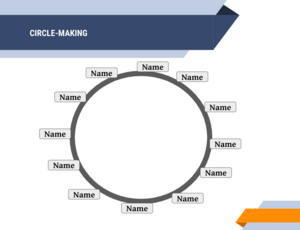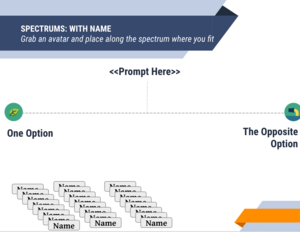Facilitation 101: Difference between revisions
| Line 124: | Line 124: | ||
| style="width: 21.7495%; background-color: rgb(197, 31, 132); border-color: rgb(0, 0, 0); height: 39px;" | '''<span style="color: rgb(255, 255, 255);" >4) Evaluation and closing</span>''' | | style="width: 21.7495%; background-color: rgb(197, 31, 132); border-color: rgb(0, 0, 0); height: 39px;" | '''<span style="color: rgb(255, 255, 255);" >4) Evaluation and closing</span>''' | ||
| style="width: 78.2137%; height: 39px;" | A quick opportunity for people to express their feelings, provide a sense of closure, and help improve the next meeting. | | style="width: 78.2137%; height: 39px;" | A quick opportunity for people to express their feelings, provide a sense of closure, and help improve the next meeting. | ||
|} | |||
{| class="wikitable" style="border-collapse: collapse; width: 83.2539%; height: 89px; background-color: rgb(255, 255, 255);" | |||
|- style="height: 20px;" | |||
| style="width: 11.5738%; background-color: #99e1d9; height: 20px;" | '''Setting the tone''' | |||
| style="height: 20px; width: 64.0131%;" | | |||
*<span>Start with confidence and energy </span> | |||
*<span>Establish consent to hold people to group agreements (see[http://lqb2.co/blog/2019/01/02/emergent-strategy-group-agreements/ this example]from Adrienne Marie Brown's[http://https//www.akpress.org/emergentstrategy.html Emergent strategy])</span> | |||
*<span>Push for specificity and test for alignment. Be suspicious </span>of agreements reached too easily – test to make sure that people really do agree on essential points. Try something like 'there's a lot of great knowledge in the room. Is there anything we're missing, anything we haven't considered?"<br> | |||
*<span>Assign observer roles (vibes, process). Helpful on zoom and/or when the #'s are large. </span><br> | |||
**<span>See [</span>[https://en.wiki.lehub.ca/index.php/How_can_we_incorporate_space_watchers_and_holders_into_our_groups_without_veering_into_policing%3F How can we incorporate space watchers and holders into our groups without veering into policing?]] for more on space watchers. | |||
**A process observer looks for things such as... | |||
***What was the general atmosphere in which the group worked? relaxed? tense? | |||
***How were the decisions made? | |||
***If there was any conflict, how was it handled? | |||
***Did everybody participate? Were there procedures that encouraged participation? | |||
***How well did the group members listen to each other? | |||
***Were there recognized leaders within the group? | |||
***How did the group interact with this facilitator? | |||
****"When you as process observer (whether appointed or not) are paying specific attention to patterns of participation, an easy device would be to keep score on papers. In a small group a mark can be made next to a person’s name every time they speak. If you are looking for differences in participation patterns between categories of people, such as around gender, race and ethnicity, new members-old member, etc, keeping track of number of contributions in each category is enough." -Berit Lakey, Training for Change | |||
|- style="height: 23px;" | |||
| style="width: 11.5738%; background-color: #99e1d9; height: 23px;" | | |||
'''Specific practices''' | |||
| style="height: 23px; width: 64.0131%;" | | |||
*Journalling before coming into discussion is helpful. Or pairing in small groups for reflection. | |||
*Look for minor points of agreement and state them. This helps build the group's morale. | |||
|- style="height: 46px;" | |||
| style="width: 11.5738%; background-color: #99e1d9; height: 46px;" | | |||
'''Handling specific situations''' | |||
| style="width: 64.0131%; height: 46px;" | | |||
*<span | |||
|} | |} | ||
Revision as of 20:21, 8 August 2023
This page was created to provide tips and suggestions for activists related to facilitating meetings and events. This guide reflects several questions the HUB community has raised on facilitation.
The information included comes from existing organizer databases and resources and advice from movement thinkers. A special thanks to HUB advisor Amara Possain, who thoughtfully shared their expertise with the HUB team. Their knowledge is shared throughout. We encourage readers to share further ideas on how this page can be expanded upon and improved.
This guide includes... definers of good vs bad facilitation, tools for good facilitation, suggestions for increasing participant engagement and suggestions for managing group dynamics.
What do we mean by facilitation? [1] [2]
The role of a facilitator is to drive meeting or event participants towards clarity. Facilitation move things forward and build momentum. Facilitators also bring participants back to the purpose of the event/meeting. Remembering your purpose is key, so that when someone is taking up too much space, the facilitator can remind that you'd like to bring us back to the purpose and our goals. -Amara Possain, HUB advisor
In other words, the role of a facilitator and the purpose of facilitation is to: Source: adapted from Meeting Facilitation: The No-Magic Method (Berit Lakey) and Seeds for Change.
|
Take responsibility for helping the group stay on track and move through the agenda within the available time. |
|
Suggest how to move the group forward, rather than making decisions or plans for the group. |
|
Regulate the flow of discussion. |
|
Track decisions and milestones, providing clarity on the group's journey, clarifying and summarizing points. |
|
Prioritize the collective needs and goals of the group over individual within the group. |
Note: A person who has strong opinions or significant investment in the decisions being made may find it challenging to facilitate effectively. In some situations, it can be helpful to have an external facilitator.
What makes for poor facilitation?
The following reflections were raised by CAN-RAC and HUB team members in a joint workshop developed and delivered by Amara Possain:
- No agenda, no steering, lack of organization
- Repetition
- Lack of momentum
- Not stepping in to help pull out the positives (groups tend to focus on negatives)
- Not stepping in when some people are taking up too much space
- Not knowing the audience and how to tailor facilitation
- Not stepping in to get people back on track, when people hijack space
- Low engagement and energy, lack of initiative
- Not being able to move past certain items
- People weaponizing meeting rules and knowledge of process
- Passive aggressiveness
- Unclear roles in non-hierarchical structure
- Interrupting each other
- “Outfacilitating" the facilitator - often around an unbalanced power dynamic
- Miscommunications / inability to diagnose where we departed in understanding
Key facilitation skills [3]
- Active listening enables us to hear what others are saying;
- Questioning helps clarify what people are saying, or supports people to explore their needs and come up with new possibilities;
- Summarising helps remind us of the key points in the discussion and check we have the same understanding;
- Synthesising is the skill that allows us to draw together different views and ideas to form one proposal that works for everyone.
Good facilitation should result in good meetings with [4] :
- Clearly defined and mutually understood goals.
- A well-defined process for effectively achieving those goals.
- Recognition that participants bring their personal preoccupations and emotions alongside their interest in the subject matter.
- Fostering a sense of involvement and empowerment, allowing participants to feel ownership over the decisions and able to take necessary actions.
Tools for good facilitation
The following tools were suggestions from HUB advisor Amara Possain.
Stop and POP [5]
Source: adapted from The P-O-P Model (Social Transformation Project, Leslie Sholl Jaffe & Randy Alford)
|
Purpose |
Why? Why are we having this meeting? What is the purpose? |
|
Outcomes |
What do we want to accomplish as a result of this meeting? |
|
Process |
What steps will we take to achieve these outcomes and fulfill the purpose? |
Structuring your agenda
|
1) Opening |
Something to help gather people, focus on the meeting, to make them feel connected to each other. |
|
2) Agenda review |
Make the agenda visible for participants with time markings. Review, make any changes, then agree to move ahead with meeting. Ideally include approx. time parkings
|
|
3) Main items |
Start with something easy to build momentum, then move on to harder items. Finish with something short and easy to provide hope for next time. |
| 4) Evaluation and closing | A quick opportunity for people to express their feelings, provide a sense of closure, and help improve the next meeting. |
| Setting the tone |
|
|
Specific practices |
|
|
Handling specific situations |
|
Suggestions for increasing participant engagement
The following is a compilation of suggestions from Seeds for Change' [6] ', Amara Possain (HUB advisor and Daniel Hunter (350.org training director) [7] . Suggestions are relevant to virtual, in-person and hybrid meetings and events.
The following are some 'energizer' activities that can help increase engagement from the beginning to end of a meeting/event: [8]
|
Sam Went to Venus |
|
|
Something True About Yourself (from Gerald Gomani, Zimbabwe) |
|
|
Strategy Stretch (from Erika Thorne, USA) |
|
|
Why… Because… (from Gerald Gomani, Zimbabwe) |
|
Suggestions for managing group dynamics
From Amara Possain, HUB advisor and Meeting Facilitation: The No-Magic Method (Berit Lakey)
| Setting the tone |
|
|
Specific practices |
|
|
Handling specific situations |
|
If you have any suggested revisions or additional resources to share related to the above content, please email them to kenzie@lehub.ca.

- ↑ https://www.trainingforchange.org/training_tools/meeting-facilitation-the-no-magic-method/
- ↑ https://www.seedsforchange.org.uk/facilitationmeeting
- ↑ https://www.seedsforchange.org.uk/facilitationmeeting
- ↑ https://www.trainingforchange.org/training_tools/meeting-facilitation-the-no-magic-method/
- ↑ http://stproject.org/
- ↑ https://www.seedsforchange.org.uk/facilitationmeeting
- ↑ https://trainings.350.org/resource/online-monster-manual/
- ↑ https://trainings.350.org/resource/gamesenergizersdynamicas/

